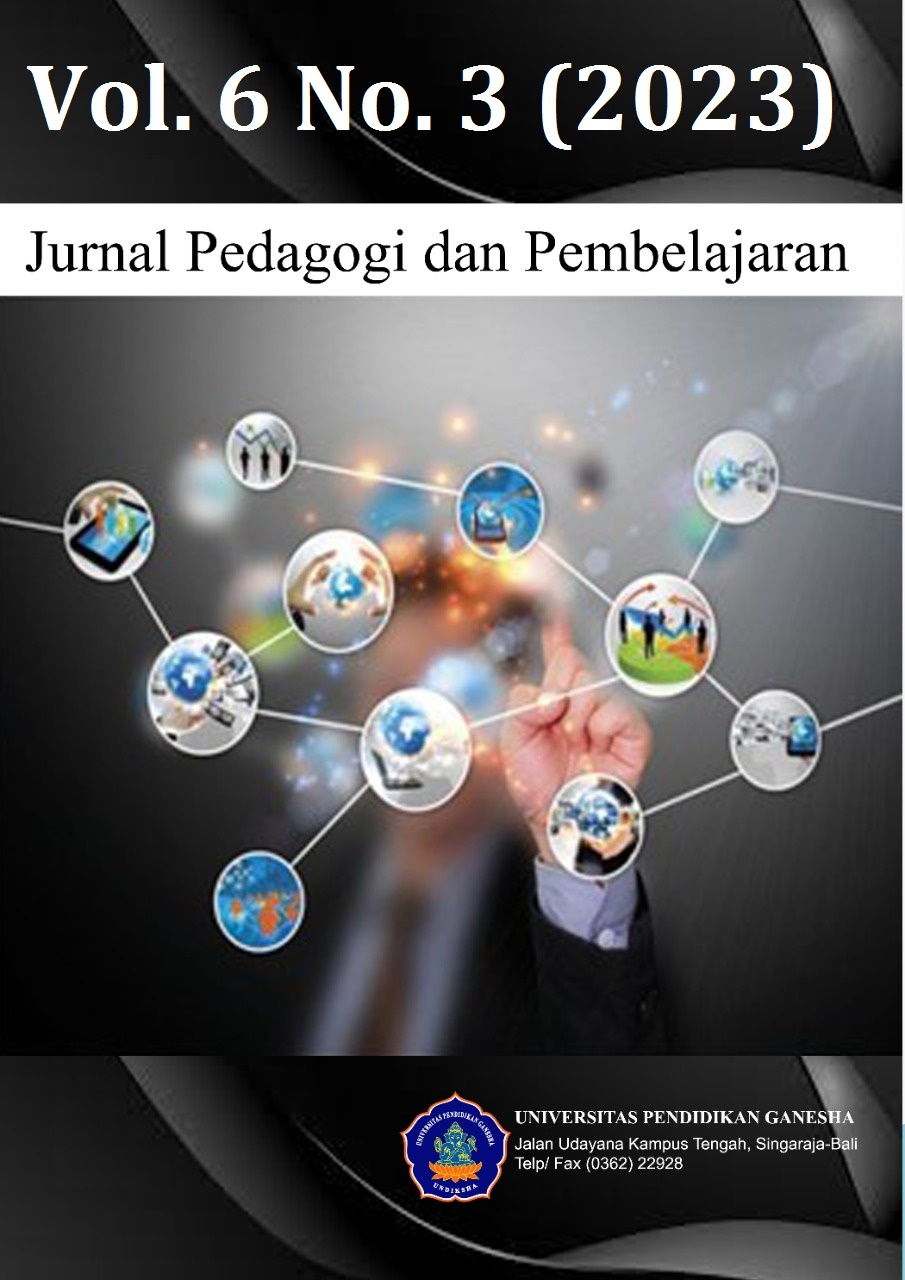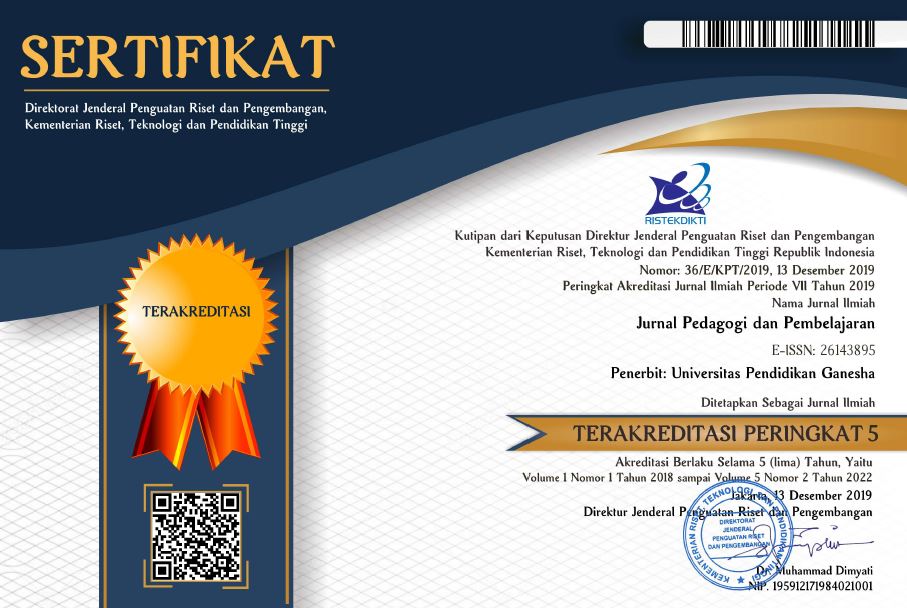Innovation Unleashed: Empowering Autistic Learners with Revolutionary Strategies and Technology
DOI:
https://doi.org/10.23887/jp2.v6i3.66844Keywords:
Autistic Learners, Technology Personalized Learning, Individualized Support, Social SkillsAbstract
An explosion of innovation using intelligence and software can potentially revolutionize growth strategies. Exploring new strategies to empower autistic students is crucial because they often experience difficulties in conventional educational environments. Based on this, this research aims to analyze the empowerment of autistic students and the use of the latest techniques and technology. This type of research is qualitative research. The method used in this research is a literature study. The method used to collect data is documentation. The instrument used to collect data was a questionnaire. The technique used to analyze data is qualitative descriptive analysis. The research results show that providing appropriate support and inclusive educational opportunities for autistic students is the most important thing. By offering tailored support, autistic students can develop essential skills for navigating various aspects of life. For example, helping them improve their social communication skills can improve their ability to form meaningful relationships and engage in collaborative activities. The need for personalized teaching and support is emphasized throughout the article as a means of addressing the unique demands of autistic students. Technology can help autistic people communicate, develop social skills, and become more independent. It is concluded that the transformative role that innovation plays in empowering autistic students and supporting the creation and adoption of innovative teaching methods and technologies on an ongoing basis.
References
AhmadAbu-Akel, E.Webb, M., Montpellier, E., Bentivegni, S., Luechinger, L., Ishii, A., & Mohr, C. (2020). Autistic and positive schizotypal traits respectively predict better convergent and divergent thinking performance. Thinking Skills and Creativity, 36. https://doi.org/10.1016/j.tsc.2020.100656. DOI: https://doi.org/10.1016/j.tsc.2020.100656
Alper, M. (2018). Inclusive sensory ethnography: Studying new media and neurodiversity in everyday life. New Media and Society, 20(10), 3560–3579. https://doi.org/10.1177/1461444818755394 DOI: https://doi.org/10.1177/1461444818755394
Alrehaili, E. A., & Al Osman, H. (2019). A Virtual Reality Role-Playing Serious Game for Experiential Learning. Interactive Learning Environments, 30(5), 922–935. https://doi.org/10.1080/10494820.2019.1703008. DOI: https://doi.org/10.1080/10494820.2019.1703008
Artun, H., Durukan, A., & Temur, A. (2020). Effects of virtual reality enriched science laboratory activities on pre-service science teachers’ science process skills. Education and Information Technologies, 25(6), 5477–5498. https://doi.org/10.1007/s10639-020-10220-5. DOI: https://doi.org/10.1007/s10639-020-10220-5
Bakker, T., Krabbendam, L., Bhulai, S., & Begeer, S. (2019). Background and enrollment characteristics of students with autism in higher education. Research in Autism Spectrum Disorders, 67(March), 101424. https://doi.org/10.1016/j.rasd.2019.101424. DOI: https://doi.org/10.1016/j.rasd.2019.101424
Beauchamp-Châtel, A., Courchesne, V., Forgeot d’Arc, B., & Mottron, L. (2019). Are tantrums in autism distinct from those of other childhood conditions? A comparative prevalence and naturalistic study. Research in Autism Spectrum Disorders, 62, 66–74. https://doi.org/10.1016/j.rasd.2019.03.003. DOI: https://doi.org/10.1016/j.rasd.2019.03.003
Becker, S. P., Breaux, R., Cusick, C. N., Dvorsky, M. R., Marsh, N. P., Sciberras, E., & Langberg, J. M. (2020). Remote Learning During COVID-19: Examining School Practices, Service Continuation, and Difficulties for Adolescents With and Without Attention-Deficit/Hyperactivity Disorder. Journal of Adolescent Health, 67(6), 769–777. https://doi.org/10.1016/j.jadohealth.2020.09.002. DOI: https://doi.org/10.1016/j.jadohealth.2020.09.002
Bousalem, Z. et al. (2018). ScienceDirect Personalized adaptive content system for context-aware ubiquitous learning. Procedia Computer Science, 127, 444–453. https://doi.org/10.1016/j.procs.2018.01.142.
Bozkus-Genc, G., & Sani-Bozkurt, S. (2022). How parents of children with autism spectrum disorder experience the COVID-19 pandemic: Perspectives and insights on the new normal. Research in Developmental Disabilities, 124. https://doi.org/10.1016/j.ridd.2022.104200. DOI: https://doi.org/10.1016/j.ridd.2022.104200
Braz, P., Felipe David, V., Raposo, A., Barbosa, S. D. J., & De Souza, C. S. (2014). An alternative design perspective for technology supporting youngsters with autism. Lecture Notes in Computer Science (including subseries Lecture Notes in Artificial Intelligence and Lecture Notes in Bioinformatics), 8534 LNAI(May 2016), 279–287. https://doi.org/10.1007/978-3-319-07527-3_26. DOI: https://doi.org/10.1007/978-3-319-07527-3_26
Cañete, R., López, S., & Estela Peralta, M. (2021). Keyme: Multifunctional smart toy for children with autism spectrum disorder. Sustainability (Switzerland), 13(7). https://doi.org/10.3390/su13074010. DOI: https://doi.org/10.3390/su13074010
Chen, S. D., Yu, Y., Li, X. K., Chen, S. Q., & Ren, J. (2021). Parental Self-Efficacy and Behavioral Problems in Children with Autism During COVID-19: A Moderated Mediation Model of Parenting Stress and Perceived Social Support. Psychology Research and Behavior Management, 14(1), 1291–1301. https://doi.org/10.2147/PRBM.S327377. DOI: https://doi.org/10.2147/PRBM.S327377
Ellis, R. A., & Bliuc, A. M. (2019). Exploring new elements of the student approaches to learning framework: The role of online learning technologies in student learning. Active Learning in Higher Education, 20(1), 11–24. https://doi.org/10.1177/1469787417721384. DOI: https://doi.org/10.1177/1469787417721384
Ezeamuzie, N. O., & Leung, J. S. C. (2022). Computational Thinking through an Empirical Lens: A Systematic Review of Literature. Journal of Educational Computing Research, 60(2), 481–511. https://doi.org/10.1177/0735633121103315. DOI: https://doi.org/10.1177/07356331211033158
Giangreco, M. F. (2021). Personalized learning for students with disabilities: The impact of the COVID-19 pandemic on inclusive education. Research and Practice for Persons with Severe Disabilities, 46(1).
Guabassi, E., & Bousalem, et al. (2018). Personalized adaptive content system for context-Aware ubiquitous learning. Procedia Computer Science, 127, 444–453. https://doi.org/10.1016/j.procs.2018.01.142. DOI: https://doi.org/10.1016/j.procs.2018.01.142
Hartung, C. M., Canu, W. H., Serrano, J. W., Vasko, J. M., & Stevens, A. E. (2020). A New Organizational and Study Skills Intervention for College Students with ADHD. Cognitive and Behavioral Practice, 9. https://doi.org/10.1016/j.cbpra.2020.09.005. DOI: https://doi.org/10.1016/j.cbpra.2020.09.005
Hasbi, M., Tolle, H., & Supianto, A. A. (2020). The Development of Augmented Reality Educational Media Using Think-Pair-Share Learning Model For Studying Buginese Language. Journal of Information Technology and Computer Science, 5(1), 38–56. https://doi.org/10.25126/jitecs.202051150. DOI: https://doi.org/10.25126/jitecs.202051150
Herlina, H., & Susilana, R. (2021). Online Training: An Alternative Solution of the Empowerment for Parents of Children with Autism. Journal of Education Technology, 5(2), 175. https://doi.org/10.23887/jet.v5i2.34313. DOI: https://doi.org/10.23887/jet.v5i2.34313
Hoxha, B. (2016). On some passions of autistic children: compensating functional language with technology (a semiotic prospective). Book of proceedings of the International Conference of Language, Literature and Culture, 120–131.
Khamparia, A., & Pandey, B. (2017). Impact of interactive multimedia in E-learning technologies: Role of multimedia in E-learning. Enhancing Academic Research With Knowledge Management Principles, April, 199–227. https://doi.org/10.4018/978-1-5225-2489-2.ch007. DOI: https://doi.org/10.4018/978-1-5225-2489-2.ch007
Klin, A., Micheletti, M., Klaiman, C., Shultz, S., Constantino, J. N., & Jones, W. (2020). Affording autism an early brain development re-definition. Development and Psychopathology, 32(4), 1175–1189. https://doi.org/10.1017/S0954579420000802. DOI: https://doi.org/10.1017/S0954579420000802
Lacka, E., Wong, T. C., & Haddoud, M. Y. (2021). Can digital technologies improve students’ efficiency? Exploring the role of Virtual Learning Environment and Social Media use in Higher Education. Computers & Education, 163. https://doi.org/10.1016/j.compedu.2020.104099. DOI: https://doi.org/10.1016/j.compedu.2020.104099
Lane, A. E., Young, R. L., Baker, A. E., & Angley, M. T. (2010). Sensory processing subtypes in autism: Association with adaptive behaviour. Journal of Autism and Developmental Disorders, 40(1). https://doi.org/10.1007/s10803-009-0840-2. DOI: https://doi.org/10.1007/s10803-009-0840-2
Laugeson, E. . (2019). The PEERS Curriculum for School-Based Professionals: Social Skills Training for Adolescents with Autism Spectrum Disorder. Routledge.
Leyman, A. (2022). Use of digital platforms by autistic children and young people for creative dress-up play (cosplay) to facilitate and support social interaction. Digital Geography and Society, 3. https://doi.org/10.1016/j.diggeo.2022.100039. DOI: https://doi.org/10.1016/j.diggeo.2022.100039
Lima, R. P., Passerino, L. M., Henriques, R. V. B., Preuss, E., & Bercht, M. (2019). Asistranto: An Assistive Educational Platform for Promotion of Interest in Autistic Children. Procedia Computer Science, 160. https://doi.org/10.1016/j.procs.2019.11.076. DOI: https://doi.org/10.1016/j.procs.2019.11.076
Malik, P. K., Singh, R., Gehlot, A., Akram, S. V., & Das, P. K. (2022). Village 4.0: Digitalization of village with smart internet of things technologies. Computers & Industrial Engineering, 165. https://doi.org/10.1016/j.cie.2022.107938. DOI: https://doi.org/10.1016/j.cie.2022.107938
Matson, J. (2009). Aggression and tantrums in children with autism: A review of behavioral treatments and maintaining variables. Journal of Mental Health Research in Intellectual Disabilities, 2(3), 169–187. https://doi.org/10.1080/19315860902725875. DOI: https://doi.org/10.1080/19315860902725875
Mayer, R. E. (2020). Where is the learning in mobile technologies for learning? Contemporary Educational Psychology, 60, 101824. https://doi.org/10.1016/j.cedpsych.2019.101824. DOI: https://doi.org/10.1016/j.cedpsych.2019.101824
Mesibov, G. B., Shea, V., & Schopler, E. (2005). The TEACCH Approach to Autism Spectrum Disorders. Springer. DOI: https://doi.org/10.1007/978-0-306-48647-0
Mohd, C. K. N. C. K., Shahbodin, F., Sedek, M., & Samsudin, M. (2020). Game based learning for autism in learning mathematics. International Journal of Advanced Science and Technology, 29(5), 4684–4691.
Nazaruddin, M. A., & Efendi, M. (2018). The Book of Pop Up Augmented Reality to Increase Focus and Object Recognition Capabilities for Children with Autism. Journal of ICSAR, 2(1), 9–14. https://doi.org/10.17977/um005v2i12018p009. DOI: https://doi.org/10.17977/um005v2i12018p009
Ozdemir, D., & Ozturk, F. (2022). The Investigation of Mobile Virtual Reality Application Instructional Content in Geography Education: Academic Achievement, Presence, and Student Interaction. International Journal of Human–Computer Interaction. https://doi.org/10.1080/10447318.2022.2045070. DOI: https://doi.org/10.1080/10447318.2022.2045070
Park, J., Bouck, E. C., & Smith, J. P. (2020). Using a Virtual Manipulative Intervention Package to Support Maintenance in Teaching Subtraction with Regrouping to Students with Developmental Disabilities. Journal of Autism and Developmental Disorders, 50(1), 63–75. https://doi.org/10.1007/s10803-019-04225-4. DOI: https://doi.org/10.1007/s10803-019-04225-4
Passerino, L. M., & Santarosa, L. M. C. (2008). Autism and digital learning environments: Processes of interaction and mediation. Computers & Education, 51(1). https://doi.org/10.1016/j.compedu.2007.05.015. DOI: https://doi.org/10.1016/j.compedu.2007.05.015
Pierce, K., & Schreibman, L. (2017). Intensive behavioural intervention for individuals with autism spectrum disorders: Transition issues. Journal of Autism and Developmental Disorders, 47(3). https://doi.org/10.5772/54274. DOI: https://doi.org/10.5772/54274
Siregar, N. C., Rosli, R., Maat, S. M., Alias, A., Toran, H., Mottan, K., & Nor, S. M. (2020). The impacts of mathematics instructional strategy on students with autism: A systematic literature review. European Journal of Educational Research, 9(2), 729–741. https://doi.org/10.12973/eu-jer.9.2.729. DOI: https://doi.org/10.12973/eu-jer.9.2.729
Srivastava, M., de Boer, A. A., & Pijl, S. J. (2017). Preparing for the inclusive classroom: changing teachers’ attitudes and knowledge. Teacher Development, 21(4), 561–579. https://doi.org/10.1080/13664530.2017.1279681. DOI: https://doi.org/10.1080/13664530.2017.1279681
Stojšić, I., Džigurski, A. I., Maričić, O., Bibić, L. I., & Vučković, S. Đ. (2016). Possible Application Of Virtual Reality In Geography Teaching. Journal of Subject Didactics, 1(2). https://doi.org/10.5281/zenodo.438169.
Tekedere, H., & Göker, H. (2016). Examining the Effectiveness of Augmented Reality Applications in Education : A Meta-Analysis. International Journal Of Environmental & Science Education, 11(16), 9469–9481. https://doi.org/10.24114/jiaf.v4i2.10808.
Tomaszewski, L. E., Zarestky, J., & Gonzalez, E. (2020). Planning Qualitative Research: Design and Decision Making for New Researchers. International Journal of Qualitative Methods, 19(1), 1–7. https://doi.org/10.1177/1609406920967174. DOI: https://doi.org/10.1177/1609406920967174
Tyler, K., MacDonald, M., & Menear, K. (2014). Physical Activity and Physical Fitness of School-Aged Children and Youth with Autism Spectrum Disorders. Autism Research and Treatment, 2014, 1–6. https://doi.org/10.1155/2014/312163. DOI: https://doi.org/10.1155/2014/312163
Van Tran, C., Pham, M. M., Mai, P. T., Le, T. T., & Nguyen, D. T. (2020). Inclusive education for students with autism spectrum disorder in elementary schools in vietnam: The current situation and solutions. International Electronic Journal of Elementary Education, 12(3), 265–273. https://doi.org/10.26822/iejee.2020358220. DOI: https://doi.org/10.26822/iejee.2020358220
Velladath, S. U., Kulkarni, M. M., Rege, S., Santhosh, S. E., & Tiwari, S. (2021). Evaluation of an interprofessional collaborative practice training module for the management of children with autism spectrum disorder. Medical Journal Armed Forces India. https://doi.org/10.1016/j.mjafi.2022.06.018. DOI: https://doi.org/10.1016/j.mjafi.2022.06.018
Downloads
Published
How to Cite
Issue
Section
License
Copyright (c) 2023 Moses Adeleke Adeoye, Hammed Olalekan Bolaji, Ajoke Kudirat Yahaya, Justina Ojoma Attah

This work is licensed under a Creative Commons Attribution-ShareAlike 4.0 International License.
Authors who publish with Jurnal Pedagogi dan Pembelajaran agree to the following terms:- Authors retain copyright and grant the journal the right of first publication with the work simultaneously licensed under a Creative Commons Attribution License (CC BY-SA 4.0) that allows others to share the work with an acknowledgment of the work's authorship and initial publication in this journal
- Authors are able to enter into separate, additional contractual arrangements for the non-exclusive distribution of the journal's published version of the work (e.g., post it to an institutional repository or publish it in a book), with an acknowledgment of its initial publication in this journal.
- Authors are permitted and encouraged to post their work online (e.g., in institutional repositories or on their website) prior to and during the submission process, as it can lead to productive exchanges, as well as earlier and greater citation of published work. (See The Effect of Open Access)










